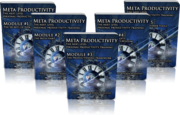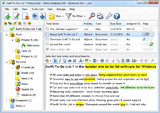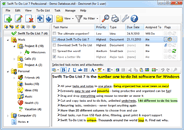This is a summary of the book The Now Habit (A Strategic Program for Overcoming Procrastination and Enjoying Guilt-Free Play) by Neil Fiore, Ph.D.
The Now Habit has been sitting on my shelf for quite some time and I’ve been putting of reading it for a few years now :-) It sounds like a joke, but it’s not – there always were more interesting books to read – or so I thought! I’m not a procrastinator – you can’t be if you want to run a successful business – but perhaps I was a bit afraid that the book might slap me in my face and force me to reconsider my approach to work and play.
Now when I’ve finally read The Now Habit, I bring you a full summary of the book so you can get the most out of it quickly. The Now Habit book is well structured and surprisingly easy to read and has given me multiple insights into procrastination and productivity.
The Now Habit book says: “People do not procrastinate because they are lazy or irrational. They procrastinate because it makes sense, given how vulnerable they feel to criticism, failure, and their own imperfection”.
The book offers a new definition of procrastination: Procrastination is a mechanism for coping with the anxiety associated with starting or completing any task or decision.
Why we procrastinate
We don’t procrastinate because we are lazy. You certainly have motivation and energy for various activities that you do daily. Procrastination is not a character defect.
We procrastinate to defend our self-worth when we feel a threat to our sense of worth and independence. We procrastinate to temporarily relieve deep inner fears.
The fears are:
- The fear of failure
- The fear of being imperfect (perfectionism)
- The fear of being overwhelmed
- The fear of success (advancement vs. friends and acceptance)
- The fear of increased demands (as a result of your good work)
To overcome these fears, you need to accept yourself as imperfect and human. Your self-worth is not defined by your output. It’s okay to make mistakes. You must stop criticizing yourself.
Procrastination is rewarding – it brings us relief and refuge. We’ve learnt to use it as a tool for solving problems. The task will often get taken care of by itself or by someone or something else.
The cycle of procrastination goes like this – the more you procrastinate, the more anxious you are, and the more you criticize yourself, and the more you lose confidence. With lost confidence, you have even greater need to use procrastination, because you are afraid that others will judge you unfavorably.
How we procrastinate
When it comes to the actual methods of procrastination, everyone is different.
The best way to learn how you procrastinate is to observe yourself for 3 days. Whenever you put something off, write down what, how, and why. Write down your feelings and thoughts. After three days, review your notes. This will give you great insight into the “why & how” of your procrastination habits. (Yes, procrastination is a habit. And like any habit, it can be changed.)
Identify the attitude and self-talk that keeps you from accomplishing your tasks.
If you were to walk a board between two skyscrapers, you would be paralyzed by fear. But if there was a 100% reliable safety net, you would dance your way to the other side. You need to create that safety net in your life.
Develop indisputable sense of worth for yourself. Allow yourself to make mistakes. Make a safe place where you are free of judgment, in your mind and in your life. Make a commitment to yourself and your self-worth. Nothing must threaten you. Allow yourself to be human.
Whatever happens, you will survive. It’s okay!
How to talk to yourself
It is very important that you master the self-talk, because it determines the whole context or your life and your attitude to everything. It determines how you feel and how you act.
The “Have To’s” are messages of stress, and the “Shoulds” are messages of depression. These messages are negative because they do not clearly communicate what you choose to do, when you choose to do it, and where you choose to start it.
Replace the negative messages with positive ones. Give yourself the power of choice. Learn to say “no” – you do not have to do anything. You can say no. Always keep that in mind.
Replace ”I have to” with ”I choose to”.
Replace ”I must finish” with ”When can I start?” (and where?).
Replace ”This is so big” with ”I can take one small step”.
Replace ”I must be perfect” with ”I can be human”.
Replace ”I don’t have time to play” with ”I must take time to play”.
The statement of a producer with a powerful focus is:
I choose to start on one small imperfect step knowing I have plenty of time for play.
Guilt-Free Play, Quality Work
This chapter could be summarized like this: Play hard, work hard. Focus on playing hard first. Schedule your play, leisure and time for friends first, and start scheduling your work only after that.
This might seem counter-intuitive at first, but it works for multiple reasons:
- First, it is an excellent reverse-psychology trick. Before you know it, whenever some of your leisure activities gets cancelled for some reason, you will be relieved and thinking Great! I can work instead!
- Second, you need the extra stimulation, socialization, relaxation and exercise for high-quality output. No one can live in a bubble and come up with creative solutions. Additionally, exercising will give you more energy.
- Third, because the time when you can work will become limited, you will automatically have a tendency to make the most out of it. You will eliminate distractions. When you work, you really work.
- Fourth, you can achieve genuine and lasting motivation only through abundant rewards. Make the periods of work shorter, but make them count.
Procrastinators have many things common with workaholics. But both of them should realize that you do not need to put of living.
Overcoming Blocks to Action
The Now Habit offers three tools for overcoming blocks to action. The tools are:
Three-dimensional thinking and the reverse calendar
Any large task can easily overwhelm you without the proper perspective. You need to consider the size, length, and breadth of your task. You need to divide the work in time. Divide and conquer :-)
Reverse calendar helps you to schedule your work realistically. You start with an ultimate deadline, and then work your way with smaller deadlines up to the present moment. All these deadlines are within your control.
The work of worrying
You should respect your ability to worry as a means to alert you of a potential danger. Whenever you worry, figure out a plan for alleviating your worries. Establish a plan how to cope with any potential danger. This will give you a true peace of mind. Constant worrying can drain your energy quickly.
Persistent starting
Summary of this passage of The Now Habit is simply “Keep on starting.” Do not think about finishing. Think about starting. Always be starting. The finishing will take care of it itself. You can start many times every day. Always focus on what you can do next. One little step.
The Unschedule
The unschedule is a weekly calendar of your recreational and non-work related activities. Personal organizer software comes in handy for that. If you fill your weekly schedule with all your daily chores, committed activities, and a scheduled leisure time, you will see that you can’t realistically work 12, 8, or maybe even 6 hours a day on your task.
The unschedule uses reverse psychology to spring you into action. You can give yourself restraints like these:
- Do not work more than twenty hours a week on this project.
- Do not work more than five hours a day on this project.
- You must exercise, play, dance at least one hour a day.
- You must take at least one day a week off from any work.
- Aim for only thirty minutes of quality work.
- Work for an imperfect, perfectly human first effort.
- Start small.
With those restrains in place, you will have a strong unconscious desire to work more, play less, and resist the “authority” of your unschedule
Keep track of every uninterrupted 30-minute block of work that you’ve done during the day. Log how many hours you have worked every day and week.
Working in the Flow State
You are most productive when you can fully focus. Distractions, intensive emotions and concerns undermine your focus and productivity. You need to deal with them before you start your work session.
Even a simple 2-minute relaxation can work wonders. Just close your eyes, breathe, and empty your mind. It’s as simple as that.
(My own suggestion is that you can also simply write your worries and “stuff” on paper, and get to them later. Your brain will let go once you write it all down.)
Fine-Tuning Your Progress
One of the techniques described in The Now Habit is called “Planned setbacks”. This could be summarized as observe and optimize. Consciously choose projects/tasks that you are most likely to procrastinate on, and observe your thoughts and feelings. This will point out the areas where further development is needed.
Another thing you can do is to develop resilience. Failing is okay. In fact, if you are fully committed to anything, you will encounter many setbacks and failures. But that’s not a bad thing. The more you fail, the closer to success you are. There are no perfect paths. Even if there are setbacks and failures, it doesn’t mean that you’ve made any mistake!
Make commitment only to goals that you fully embrace. Do not set goals that you simply do not care about. It’s a waste of time that will lead only to unhappiness.
The Procrastinator in Your Life
Until you understand procrastination yourself, you will probably reinforce procrastination patterns in the people around you. Successful leaders communicate in a way that makes people commit, not comply. They state priorities clearly, and give rewards and praise frequently.
Successful managers invite commitment. For example, “What can you get to me in a rough form by noon?” instead of “You’d be better finished by noon.” They also place emphasis on starting, not finishing. They are clear about where to start. They never criticize the person, but only their output, and they never hesitate to give praise when it’s appropriate.
When dealing with your family members, always make it your fault, not theirs. Use sentences like “I’m so obsessed with being there early! I simply have to leave on time, so I’m leaving in 20 minutes. It would be great if you could join me, but it’s up to you.”
Summary Conclusion
If you apply the techniques and methods presented in The Now Habit, not only you will eliminate procrastination, but your overall quality of life and happiness will permanently increase. Not many books can have so dramatic impact on your permanent happiness.
I can recommend The Now Habit to anyone, not just people that are dealing with procrastination.






That’s really a wonderful summary of the book. Kudos Jiri. However, I’m not fully comfortable with how many look at procrastination like the devil, and how it has to be slayed at all costs. There are ways in which you can actually convert the procrastination habit to aid you in achieving your goals. Have a look at this blog post on how to procrastinate efficiently , where the concept is explained well – http://blog.classof1.com/how-to-procrastinate-efficiently/
Very nice summary – just listened to audiobook and this totally reflects all the main ideas.